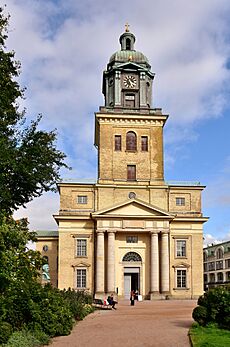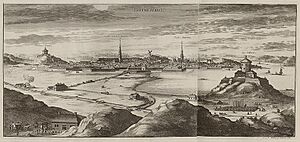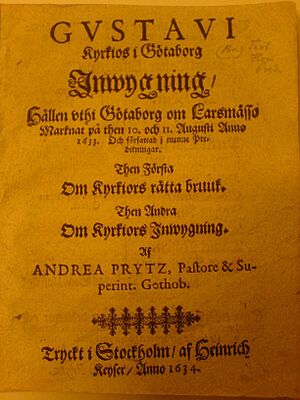Gothenburg Cathedral facts for kids
Quick facts for kids Gothenburg Cathedral |
|
|---|---|
| Gustavi domkyrka | |

Frontview of the Gothenburg Cathedral
|
|
| 57°42′16″N 11°57′55″E / 57.70444°N 11.96528°E | |
| Location | Gothenburg |
| Country | Sweden |
| Denomination | Church of Sweden |
| Architecture | |
| Architect(s) | Carl Wilhelm Carlberg |
| Style | Classicism |
| Administration | |
| Diocese | Diocese of Gothenburg |
Gothenburg Cathedral (also known as Gustavi domkyrka) is a very important church in Gothenburg, Sweden. Gothenburg is the second largest city in the country. This cathedral is the main church for the Diocese of Gothenburg within the Church of Sweden.
Contents
The First Church in Gothenburg
Before the first big cathedral was built, there was a temporary church. It was called the Gothenburg stave church (Brädekyrkan). This simple wooden church stood on the same spot for about 12 years. It was one of the very first buildings in the city of Gothenburg.
Building the First Cathedral
Building a new, bigger church started in 1627. King Gustavus Adolphus of Sweden helped pay for it by creating a special tax. Farmers had to give a barrel of grain from their church-owned land for several years.
Master mason Lars Nilsson led the construction. The first stone was laid on June 19, 1626. The main part of the new church was finished in 1633. The old wooden church was taken down, but its tower was used as a guard tower for a while.
The church was first called "the great church." It was officially opened on August 10 and 11, 1633. This event is still remembered with a special sermon every year. The church became a "cathedral" in the 1680s.
Three large bells were hung in the tower. Their sound could be heard for over 8 kilometers! A smaller bell on the north wall chimed the hour. The first tower clock was made in 1648.
The church was built with granite and Dutch bricks. It had 18 large windows and a fancy entrance. The building was about 48 meters long and 20 meters wide. Its roof was covered with oak shingles and copper plates.
Inside the First Cathedral
The cathedral had 17 large columns inside. These columns supported the roof.
The first pulpit (where sermons are given) was made in Germany or by German artists. It was replaced in the 1670s by a new one. This new pulpit was carved from alabaster and ebony by Marcus Jaeger the Elder. He also made the baptismal font and carved decorations on the pews.
There was also a special royal seat, or throne, for the king. It was covered in red velvet and decorated with white alabaster and gold.
The first organ was installed by 1648. A new, bigger pipe organ was finished in 1661. Marcus Jaeger also helped by adding four large pillars to support the organ.
Why it Became a Cathedral
The church was named "Gustavi church" after King Gustavus Adolphus. It was also called the Swedish Church to tell it apart from Gothenburg's German Church. In 1665, it became a cathedral because a bishop's office was created there.
Burial Grounds
The area around the cathedral was used as a burial ground since 1645. It was called Domkyrkoplatsen (Cathedral Square). A wall with arched gates surrounded the cemetery.
The Second Cathedral
On April 15, 1721, a big fire destroyed the cathedral and many nearby houses. Luckily, the cathedral walls were still standing. This meant the church could be rebuilt quickly.
The cathedral reopened on May 25, 1722, just 13 months after the fire. It had the same size as before. However, the roof leaked a lot, so a new copper roof was added in 1726.
The tower took longer to finish. A temporary bell tower was used in the churchyard until 1732. The new tower was designed by Nicolaus Müller. It looked similar to the tower of the German Church. Three large bells were cast for the new tower in 1726.
The ceiling was finished between 1734 and 1739. The floor was laid in 1740 with 1,400 large limestone tiles. A new organ was built in 1733–1734. It had 32 stops and 5 bellows.
In 1750, a beautiful sculpted altarpiece was suggested. It shows Christ, a cross, and two kneeling angels. This altarpiece was finished in 1754 and is still used today.
A building for storing coffins, called a charnel house, was built in 1769. This was to prevent bad smells in the church. The churchyard wall was also finished that year.
The Third (Current) Cathedral
Another big fire happened on December 20, 1802. This fire destroyed the second cathedral and 179 houses. The damage was so bad that the old walls could not be used again.
Building a brand new church started in 1804. Some parts of the old church's foundations were reused. Stones from the old church were even used for other buildings in the city.
The new cathedral was designed by architect Carl Wilhelm Carlberg. He passed away before it was finished, so his student, Justus Frederick Weinberg, completed the work. The church was officially opened on May 21, 1815.
The tower was finished ten years later, in 1825. Its copper covering was added in 1827. A second opening ceremony was held on September 9, 1827.
After the 1802 fire, the old cemetery became an open square called Kyrkotorget. Later, it was paved with cobblestones and renamed Domkyrkoplatsen in 1846. Trees were planted around the church in 1851, and an iron fence was added around 1860.
It's thought that about 20,000 people were buried in the church area over the centuries. Another 3,000 people were buried inside the church itself between 1635 and 1802. A plaque outside the church reminds visitors of this history.
Gothenburg Cathedral was the first church in Sweden to get central heating in 1852. Gas lighting was installed in 1853.
In the early 1900s, the church tower started to lean. The church had to be closed for a long time for repairs. Services were held in other churches.
Major renovations happened in 1904. The church got new floors, windows, doors, and benches. More work was done in the 1950s to make the building more stable. Another renovation took place from 1983 to 1985.
Until the late 1990s, you could visit the cathedral tower. You could take an elevator and then climb 151 steps to a small balcony. During elevator work in 2013, parts of the first cathedral's walls were found under the floor.
Cathedral Architecture and Style
The current cathedral is built in a classical style. It is larger than the previous two churches. It is now about 59.4 meters long and 38 meters wide. The main part of the church is 22.86 meters wide. The inside height of the main area is 14.25 meters, and the tower reaches 52.85 meters high.
A good example of the classical style is the large main entrance at the west end. It has four Doric columns.
Inside the Cathedral
The inside of the cathedral mixes different styles. You can see classical and Empire style elements. The columns inside are classical, made of red marble with gold at the top.
The Empire style is seen in the white and gold decorations. This style is also in the special bench for the bishop and the wall clock. The pulpit, designed by Axel Magnus Fahlcrantz, is also in the Empire style.
The angel figures on the altar are in a Baroque style. They are from the old altar set from the 1700s and were saved from the 1802 fire.
The old white and gold grandfather clock in the cathedral is from the 1700s. It was also saved from the 1802 fire. It was made in 1751 by Olof Rising.
The Organ
The current organ in the church was built in 1962. However, it still has its original front, which is white and gold. The previous organ was started in 1805 but finished in 1816.
Images for kids







